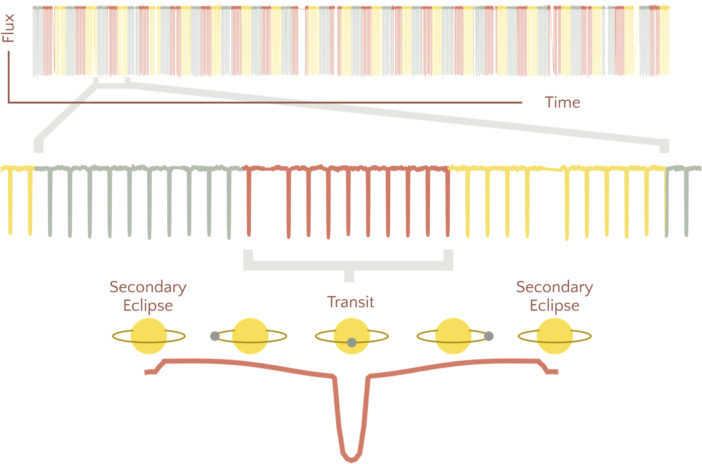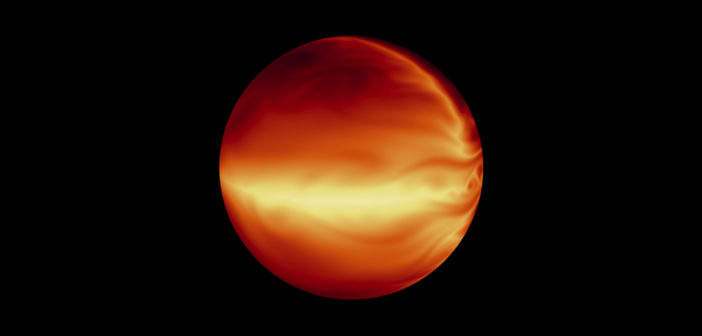Editor’s Note: Astrobites is a graduate-student-run organization that digests astrophysical literature for undergraduate students. As part of the partnership between the AAS and astrobites, we occasionally repost astrobites content here at AAS Nova. We hope you enjoy this post from astrobites; the original can be viewed at astrobites.org.
Title: Reassessing the Evidence for Time Variability in the Atmosphere of the Exoplanet HAT-P-7 b
Authors: Maura Lally and Andrew Vanderburg
First Author’s Institution: Cornell University, Northwestern University, and University of Texas at Austin
Status: Published in AJ
It would make sense, given the ever-changing atmospheres of Earth and the other solar system planets, that exoplanets would also be host to their own kinds of “weather.” But, despite the many characterised exoplanet atmospheres, confidently detecting a changing atmosphere remains extremely challenging. Previous attempts to assess the variability of exoplanet atmospheres have used phase curves — a measure of the changes in observed stellar flux over a planet’s entire orbit as it passes in front of and behind its star (see, for example, Figure 1). For tidally locked planets like hot Jupiters, different parts of the atmosphere will be visible as the planet moves around its star, so the shape of the phase curve can provide information about the planet’s atmosphere. By monitoring how the phase curve varies over time, you can decipher if the atmosphere is varying.

Figure 1: An overview of the Kepler data analysed in the article. Top: the entire light curve of HAT-P-7, split into 60 chunks each containing 10 transits. Middle: A zoom in on 70 days of observations. Bottom: An example phase curve along with the positions of the planet as it completes its orbit. [Lally & Vanderburg 2022]
Back to Basics
As an initial test, the authors first analysed the many phase curves in the original Kepler data to see if they obtained the same hotspot offset variability as Armstrong et al. To ensure that the result wasn’t influenced by any analysis choices, the authors repeated their methods on different outputs of the Kepler data reduction pipeline and tested different model choices to compare the results.
As seen in Figure 2, the authors’ offset measurements were comparable to those of Armstrong et al., although the offset was only seen to vary by up to 30 degrees — a result that was robust for all their analysis choices. But is this variability actually coming from the planet’s atmosphere? To determine if the host star could be causing the phase curves to vary, the authors injected simulated non-varying planetary phase curve signals into the light curves of a selection of stars similar to HAT-P-7 and extracted the resulting hotspot offsets. This test showed that similar variability could be recovered from the injected light curves, meaning that it’s possible that HAT-P-7b’s hotspot offset might not be varying after all! Given that Kepler was known to be a very well-behaved instrument, the stars themselves must be varying and contributing additional noise to the phase curves.

Figure 2: The measured hotspot offsets from HAT-P-7b’s phase curve over the course of the observations. The values calculated by Armstrong et al. are shown in pink open circles, while the values the authors calculated for a selection of phase curves are shown in red filled circles. Both analyses are a good match, indicating that the respective methodologies are unlikely to be causing the variability. [Adapted from Lally & Vanderburg 2022]
Tuning Out the Noise
To understand what sources of noise might be impacting HAT-P-7b’s phase curve, the authors produced the power spectrum of the light curve of HAT-P-7. They then compared it to a white noise spectrum, as shown in Figure 3, to identify at what frequencies significant sources of noise were occurring.

Figure 3: The power spectrum of HAT-P-7’s light curve (grey), showing how sources of noise are occurring over a range of frequencies. An equivalent white noise spectrum is shown in blue, highlighting that HAT-P-7 has significant excess noise at lower frequencies. [Lally & Vanderburg 2022]
With all this evidence to hand, the authors conclude that the varying offset measurements of HAT-P-7b are likely not related to atmospheric variability, and supergranulation is the culprit of the changing phase curves. Although Kepler is now decommissioned, the analysis performed in today’s article provides a helpful tool for verifying past and future claims of exoplanet weather from it or any other telescope, including JWST.
Original astrobite edited by Yoni Brande.
About the author, Lili Alderson:
Lili Alderson is a second-year PhD student at the University of Bristol studying exoplanet atmospheres with space-based telescopes. She spent her undergrad at the University of Southampton with a year in research at the Center for Astrophysics | Harvard-Smithsonian. When not thinking about exoplanets, Lili enjoys ballet, film, and baking.
